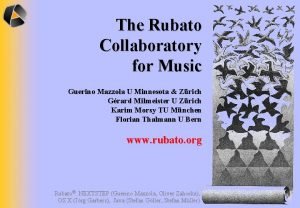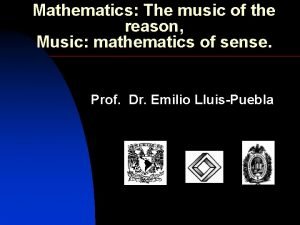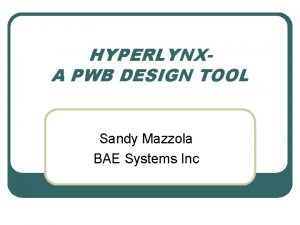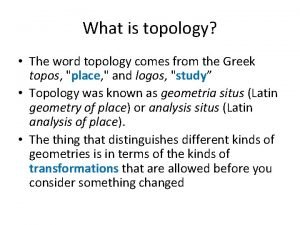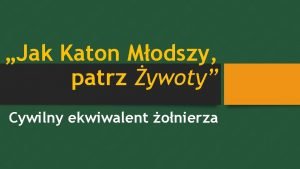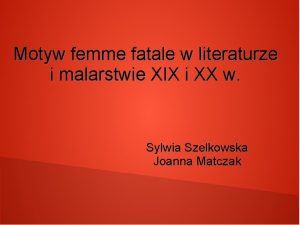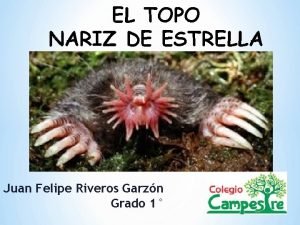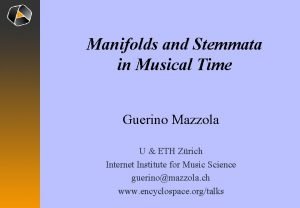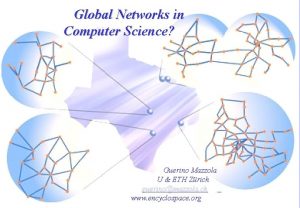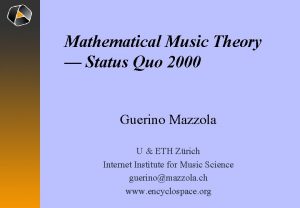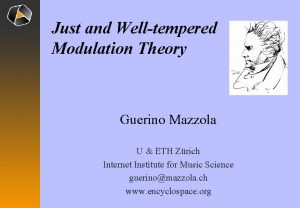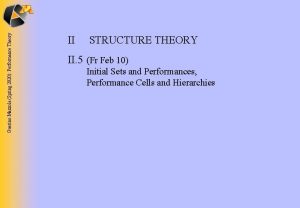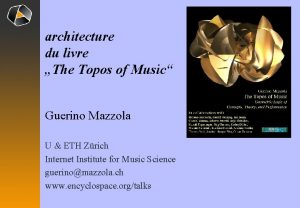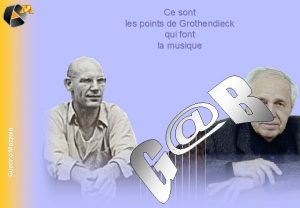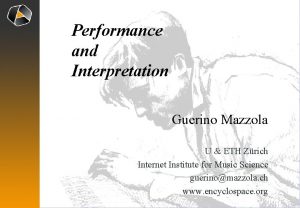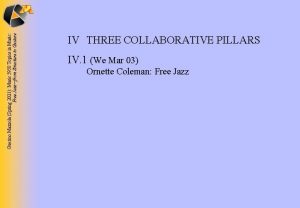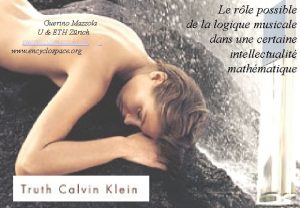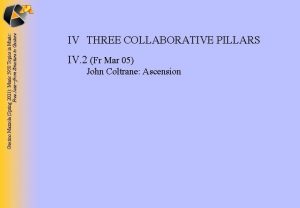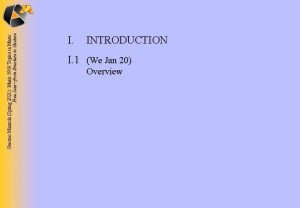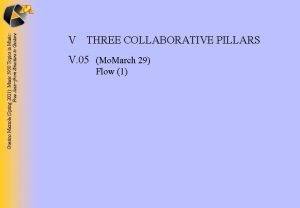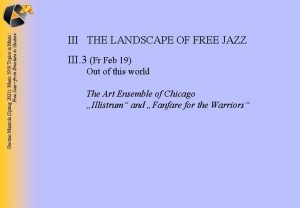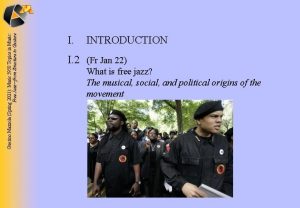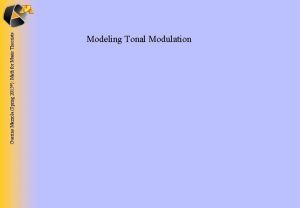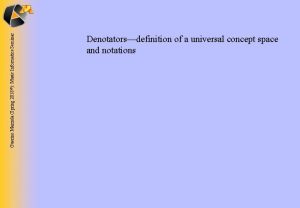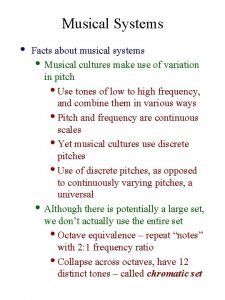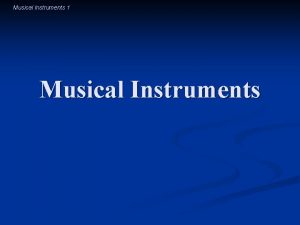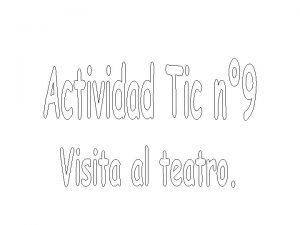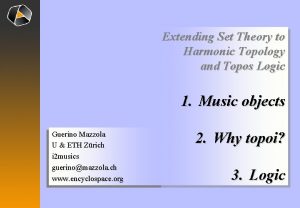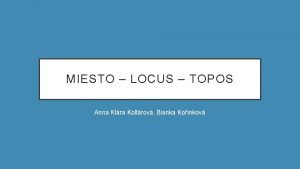Topos Theory for Musical Networks Guerino Mazzola U





















































- Slides: 53

Topos Theory for Musical Networks Guerino Mazzola U & ETH Zürich guerino@mazzola. ch www. encyclospace. org

Birkhäuser 2002 1365 pages, hardcover incl. CD-ROM US English ISBN 3 -7643 -5731 -2 Networks etc. —> PNM paper Mazzola + Andreatta

Wolfgang Graeser 1906 -1928 Bach‘s „Art of Fugue“ (1924) Eine kontrapunktische Form ist eine Menge von Mengen (von Tönen). A contrapuntal form is a set of sets (of tones).

Structures T N E M ! E E L R P A Processes M I W T F O S ON Gestures


Need recursive (possibly circular) combination of constructions such as „sequences of sets of curves of sets of chords“ etc. This leads to theory of denotators: —> concept architecture —> uses mathematical topos theory —> generalizes XML —> have implementation in Java

Anchor. Note Rest Note Onset Duration Onset Pitch Loudness Duration – – – Ÿ STRG –

Macro. Note • Ornaments • Schenker analysis Satellites Anchor. Note Macro. Note Rest Onset – Note Duration – Onset Pitch – Ÿ Loudness Duration STRG –

disjunction disjoint sum colimit conjunction cartesian product limit Makro. Note ! S M E L B O PR Satellites Anchor. Note Makro. Note Resr Onset – Note Duration – Onset – Pitch Ÿ Loudness STRG selection set powerset Duration – representation algebraic space group, module, etc.

F = EHLD (onset E, pitch H, loudness L, duration D, values in —) x: 0 — H 4 x A=0 D E L p A=0 F = Pi. Mod 12 (pitch classes in Ÿ 12) p: 0 Ÿ 12

Alexander Grothendieck a point is an affine map f space F „address“ A A@F

Dodecaphonic Series Ÿ 12 S 0 A = Ÿ 11, F = Pi. Mod 12 S: Ÿ 11 Ÿ 12, S Ÿ 11@Ÿ 12 ª Ÿ 1212 11

Prize for parametrization addresses: Parametrized objects need parametric evaluation! address A space F address B parametric evaluation A@F B@F = address change = functoriality!

Sets cartesian products X Y disjoint sums X È Y powersets XY characteristic maps c: X 2 no „algebra“ Mod@ F: Mod Sets space functors have all these properties Mod direct products A≈B etc. has „algebra“ no powersets no characteristic maps Mod@ is a Topos

What is a space functor F: Mod Sets? 1. For every address module A in Mod, we have set A@F of „A-addressed points of F“. 2. For every (affine) module homomorphism f: B —> A, have set map F(f): A@F—> B@F 3. F(Id. A)= Id. A@F, F(g f)=F(f) F(g) Example: F= @M „space of points of M“ A@F = A@M A B M

Yoneda Lemma The map @: Mod@ is fully faithful. M ~> @M M@F ≈ Hom(@M, F) Mod@ Const. Sets @Mod @ Mod spaces = functors 21 st century geometry is about functors

The Topos of Music is mainly concerned with powerset type categories and their classification: „Local and global compositions“

disjunction disjoint sum colimit conjunction cartesian product limit Makro. Note Satellites Anchor. Note Makro. Note Resr Onset – Note Duration – Onset – Pitch Ÿ Loudness STRG selection set powerset Duration – representation algebraic space group, module, etc.

Henry Klumpenhouwer: Deep Structure in K-net Analysis with Special Reference to Webern‘s Opus 16, 4 Atlas for global composition made of 8 local compositions I 1 , I 2 , I 3 , I 4 , I 5 , I 6 , I 7 , I 8 I 1 I 2 I 3 I 4 I 5 I 6 I 7 1 -dimensional nerve of global composition J 1 , J 2 , J 3 , J 4 , J 5 , J 6 , J 7 , J 8 Jk 0@Pi. Mod 12 J 1 J 2 J 3 J 8 J 4 J 7 J 5 J 6 class 19 class 22 class 28 class 31 I 8

Klumpenhouwer (hyper)networks J 1 J 2 J 3 J 4 Db}

Guerino Mazzola: Circle chords (Lectures on Group-theoretic Methods in Music Theory, U Zurich 1981, Gruppen und Kategorien in der Musik, Heldermann, Berlin 1985) Ch = f (x) = {x, f(x), f 2(x), . . . } „orbit“ of x under monoid generated by affine map f

Klumpenhouwer (hyper)networks J 1 J 2 J 3 J 4 Db}

T 5. -1 2 Ÿ 12 T 4 D 7 Ÿ 12 T 11. -1 Ÿ 12 T 2 Ÿ 12 3 4 Ÿ 12 (3, 7, 2, 4) lim(D) T 4 T 5. -1 Ÿ 12 T 11. -1 T 2 Ÿ 12

Zi = Ÿ 12 fijt Z i@ Z j Zi filq fijt fjms (empty or) subgroup of (Ÿ 12)n If f*** = isomorphisms card (U) (= 0 or) divides 12 D Zj Fact: lim(D) U U= fllr Zm lim(D) flip fjlk Zl

Zi = module fijt Z i@ Z j Zi fllr filq diaffine morphism fijt D Zj lim(D) (empty or) module fjms Zm lim(D) flip fjlk Zl

A 2 A 5 A 4 A 1 A 3 B 1 B 2 B 3 B 4 David Lewin: Analysis of Stockhausen‘s Klavierstück III (Musical Form and Transformation: 4 Analytic Essays, Yale U Press, 1993) B 5

Zi = P(Mi ), Mi = module fijt = powerset map P(gijt ) Zi induced by diaffine morphisms gijt Mi P(Mi ): x ~> {x} special case of singletons! B 1 fllr filq fijt B 2 D Zj fjms Zm (B 1, B 2, B 3 , B 4 , B 5) lim(D) flip fjlk Zl

Zi = space functors over modules fij* = natural transformation Zi fijt filq D Zj lim(D) space functor fjms Is this necessary? lim(D) fllr Zm flip fjlk Zl

0@N = {(di)affine maps f: 0 N} N 0@Zi A@ Replace module N by its space functor @N: A ~> A@N 0@ f tt A@ 0@ fililqq A@ 0@ fflilipp A@ 0@ fllr A@ 0@Zl A@ ijij Replace powerset P(N) by the space functor P(N): A ~> A@P(N)= P(A@N) advantages? 0@Zjj A@ 0@ fjlk A@ ss 0@ fjm A@ jm 0@Zm A@ • Avoid reinventing the whole theory for each address A 0@ lim(of Daddress ) A@ • Have transition mechanisms change B A

Networks of Dodecaphonic Series T 5. -1 Ÿ 11@ Ÿ 12 S r: Ÿ 11 S. r Ÿ 11@ Ÿ 12 D T 2 U Ÿ 11@ Ÿ 12 T 11. -1 Ÿ 11@ Ÿ 12 => network of retrograde series Ÿ 11@ Ÿ 12 T 4 R V

D = diagram of space functors Fi P(F ) = one of these power spaces: Fi filq F F 2 Fin(F). . . P(D) = canonical power space diagram with above power spaces P(Fi) „Network space of D“ fllr fijt D Fj flip fjlk fjms Fm FD: . Limit(P(D)) Fl

Ÿ 12 T 0 T 5. -1 Ÿ 12 T 9. -1 T 4 T 2 Ÿ 12 T 4 Ÿ 12 T 0 T 11. -1 Ÿ 12 T 3. -1 T 4 T 0 T 4 Ÿ 12 T 4 T 0 Ÿ 12

Fi fllr filq fijt D Fj fjms Fm flip Gi si Fl sl fjlk gijt D* Gj sj gjms sm Gm s FD Fs gllr gilq F D* glip gjlk Gl

Summarizing recursive procedure: 1. Given are -> Category C of spaces -> Diagram scheme D. 2. Consider category Dia(D, C ) of diagrams D over D with values in C, plus natural transformations S: D D*. 3. Define category C (1) =D PC of limits FD of power diagrams P(D) of one of the power types P = D, 2 D, Fin(D), . . . , together with morphisms FS : FD FD*. 4. Restart the procedure from 1. with the new category C (1) and a new diagram scheme D(1), defining the category C (2) =D(1) P (1) C (1), and so on. . . Problem: ¿Is there an operation P on diagram schemes with (D(1) PD) PC =D(1) P(D PC )

global compositions charts atlases

A 2 On. Pi(Ÿ 2) A 5 A 4 A 1 A 3 B 1 B 2 B 3 hism p r o M al b o l g f of B 4 s n o i t i s compo B 5 Pi. Mod 12 B 1 nerve( f ) A 3 A 1 A 2 A 5 B 3 B 4 B 2 A 4 B 5 2 -dimensional nerve 3 -dimensional nerve

I II IV V VI VII

The class nerve cn(K) of global composition is not classifying 2 5 II 2 10 5 10 2 10 6 2 V VII 10 2 VI IV 2 6 2 2 5 15 2 2 10 I 2 6 5 2 2 2 10 III

n/16 0 a b c d e 2 3 4 6 8 10 12

n/16 0 2 3 4 6 8 10 12 a b c d nerve of the covering {a, b, c, d, e} e c a b e d

K Kt Í C t C i ◊ Ki ◊ ◊ Kit local iso Kti KI

Have universal construction of a „resolution of KI“ res: A n* KI It is determined only by the KI address A and the (weighted) nerve n* of the covering atlas I. res A n* KI

3 6 1 4 5 0 n* res 2 4 6 2 2 1 5 1 4 d c a b 4 5 KI 6 3 1 3 6 3 2 5

3 6 1 4 5 i (Ki) res ( i) res 2 4 6 3 A@R (K i ) Ki 1 5 2 (Ki) = module of affine functions on Ki

3 6 1 4 (Ki) res ( i) 2 A@R i 5 (Ki Kj) res ( i i)

n* ≈ n*(KI) = nerve of KI , n* A n*( ) —» A n*( ) homomorphism of R-modules KI( ) res » A n*( ) » KI( ) res*n (KI) n (A n*)

D(n*) = diagram of function spaces F F f ( / ) P(F ) = Sub. Mod(F ) P(D (n*)) = canonical power space diagram with the above power spaces P(F ) D(n*) f ( / ) F „Network space of D(n*) “ FD (n*) : . Limit(P(D(n*) )) KI-Functions: A@FD (n*) (res*n (KI)) F

Yi vi vi Yl vl vl vj vj Yj vm vm Ym cartesian vi vi vj vj Xi Yl Yj network isomorphisms Xi Xl chart Yi vl vl Xj chart Xl Xj

Theorem: There is functor |? |: Glob. Limred. A —> Glo. Com. A ~> K |K| 4 4 6 6 3 3 1 2 5 1 2 Corollary: There are proper global networks (limits) 5

Structures Processes ! ? ? Gestures

Remark on automorphism groups on Ÿ 12 Aut(Ÿ 12) = TŸ 12 | Ÿ 12* T/I group = subgroup of Aut(Ÿ 12) T/I group = TŸ 12 | (± 1) Ÿ 12 | Ÿ 2 Int: Aut(Ÿ 12) Aut(T/I group) Ÿ 12 | Ÿ 12* Ker(Int) = <T 6 > Ÿ 2 <j, n>(Tu) = Tnu, n Ÿ 12* ={1, 5, 7, 11} <j, n>(-1) = Tj(-1) Int(Ts(n)) = <2 s, n> Im(Int) 2Ÿ 12 | Ÿ 12*

Remark on isographies on Ÿ 12 An isography between two diagrams D, D* : D T/I-group over the same diagram scheme D with values in category T/I-group with • the single object Ÿ 12 • morphisms = T/I-group isomorphisms is a group automorphism f (= a functorial automorphism) f: T/I-group D D* T/I-group f ~ such that D* = f D D T/I-group

Unfortunately, an isography f between two diagrams D, D* : D T/I-group does not tell anything about the underlying limits! Example: D Ÿ 12 lim(D) = Ø T 2 q+1(-1) x = 2 q+1 -x <2 q+1, 1> D* lim(D *) Ø Ÿ 12 T 2(2 q+1)(-1) x = 2(2 q+1) -x However, an isography with <2 s, n>, stemming from conjugation, preserves limits, i. e. , it is a natural transformation!
 Guerino mazzola
Guerino mazzola Grothendieck
Grothendieck Jared frick
Jared frick Sandy mazzola
Sandy mazzola What is topology
What is topology Katon dp
Katon dp Kompozycja pierścieniowa
Kompozycja pierścieniowa Femme fatale w malarstwie
Femme fatale w malarstwie Topo de nariz de estrella
Topo de nariz de estrella Datagram networks
Datagram networks Backbone networks in computer networks
Backbone networks in computer networks Iso 22301 utbildning
Iso 22301 utbildning Novell typiska drag
Novell typiska drag Nationell inriktning för artificiell intelligens
Nationell inriktning för artificiell intelligens Ekologiskt fotavtryck
Ekologiskt fotavtryck Shingelfrisyren
Shingelfrisyren En lathund för arbete med kontinuitetshantering
En lathund för arbete med kontinuitetshantering Adressändring ideell förening
Adressändring ideell förening Tidbok yrkesförare
Tidbok yrkesförare A gastrica
A gastrica Vad är densitet
Vad är densitet Datorkunskap för nybörjare
Datorkunskap för nybörjare Tack för att ni lyssnade bild
Tack för att ni lyssnade bild Att skriva en debattartikel
Att skriva en debattartikel Delegerande ledarskap
Delegerande ledarskap Nyckelkompetenser för livslångt lärande
Nyckelkompetenser för livslångt lärande Påbyggnader för flakfordon
Påbyggnader för flakfordon Vätsketryck formel
Vätsketryck formel Offentlig förvaltning
Offentlig förvaltning Urban torhamn
Urban torhamn Presentera för publik crossboss
Presentera för publik crossboss Teckenspråk minoritetsspråk argument
Teckenspråk minoritetsspråk argument Vem räknas som jude
Vem räknas som jude Klassificeringsstruktur för kommunala verksamheter
Klassificeringsstruktur för kommunala verksamheter Epiteltyper
Epiteltyper Bästa kameran för astrofoto
Bästa kameran för astrofoto Cks
Cks Programskede byggprocessen
Programskede byggprocessen Mat för idrottare
Mat för idrottare Verktyg för automatisering av utbetalningar
Verktyg för automatisering av utbetalningar Rutin för avvikelsehantering
Rutin för avvikelsehantering Smärtskolan kunskap för livet
Smärtskolan kunskap för livet Ministerstyre för och nackdelar
Ministerstyre för och nackdelar Tack för att ni har lyssnat
Tack för att ni har lyssnat Mall för referat
Mall för referat Redogör för vad psykologi är
Redogör för vad psykologi är Stål för stötfångarsystem
Stål för stötfångarsystem Tack för att ni har lyssnat
Tack för att ni har lyssnat Borra hål för knoppar
Borra hål för knoppar Vilken grundregel finns det för tronföljden i sverige?
Vilken grundregel finns det för tronföljden i sverige? Hur räknar man standardavvikelse
Hur räknar man standardavvikelse Tack för att ni har lyssnat
Tack för att ni har lyssnat Rita perspektiv
Rita perspektiv Informationskartläggning
Informationskartläggning
